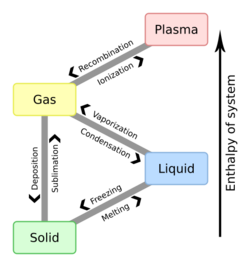Physics:Quasi-solid
This article needs additional citations for verification. (December 2009) (Learn how and when to remove this template message) |
Quasi-solid, Falsely-solid, or semisolid is the physical term for something whose state lies between a solid and a liquid. While similar to solids in some respects, such as having the ability to support their own weight and hold their shapes, a quasi-solid also shares some properties of liquids, such as conforming in shape to something applying pressure to it and the ability to flow under pressure.[citation needed] The words quasi-solid, semisolid, and semiliquid may be used interchangeably.
Quasi-solids and semisolids are sometimes described as amorphous because at the microscopic scale they have a disordered structure unlike crystalline solids. They should not be confused with amorphous solids as they are not solids and exhibit properties such as flow which bulk solids do not.
Examples
- Pharmaceutical and cosmetic creams, gels, and ointments,[1] e.g. petroleum jelly, toothpaste, hand sanitizer
- Foods, e.g. pudding, guacamole, salsa, mayonnaise, whipping cream, peanut butter, jelly, jam
See also
References
 |


